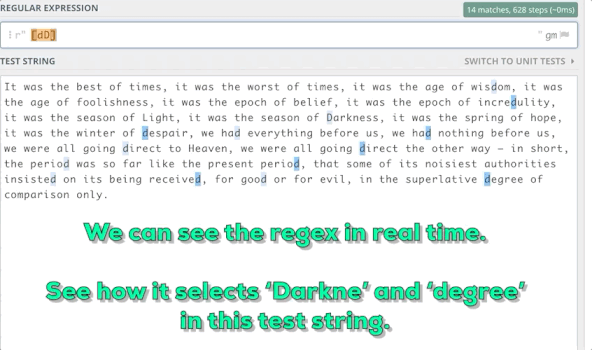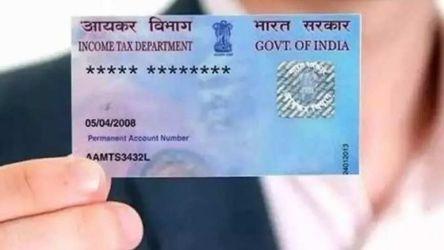处理文本数据的一个主要任务就是创建许多以文本为基础的特性。
人们可能想要在文本中找出特定格式的内容,比如找出存在于文本中的电子邮件,或者大型文本中的电话号码。
虽然想要实现上述功能听起来很繁琐,但是如果使用Python正则表达式模块,就可以使这一操作更加简单。
假设要在一篇特定的文章中找出标点符号的数量。以狄更斯的作品文本为例。
你通常会怎么做?
最简单的方法如下:
- target = [';','.',',','–']
- string = "It was the best of times, it was the worst of times, it was the age of wisdom, it was the age of foolishness, it was the epoch of belief, it was the epoch of incredulity, it was the season of Light, it was the season of Darkness, it was the spring of hope, it was the winter of despair, we had everything before us, we had nothing before us, we were all going direct to Heaven, we were all going direct the other way – in short, the period was so far like the present period, that some of its noisiest authorities insisted on its being received, for good or for evil, in the superlative degree of comparison only."
- num _ points = 0
- num_puncts = 0
- for punct in target:
- if punct in string:
- num_puncts+=string.count(punct)print(num_puncts)
- ------------------------------------------------------------------
- 19
如果没有可支配的re模块,那就要用到上面的代码。但如果有re模块,则只需两行代码:
- import re
- pattern = r"[;.,–]"
- print(len(re.findall(pattern,string)))
- ------------------------------------------------------------------
- 19
本文讨论的是最常用的正则表达式模式,以及一些经常使用的正则表达式函数。
什么是正则表达式?
简而言之,正则表达式(regex)用于探索给定字符串中的固定模式。
我们想找到的模式可以是任何东西。
可以创建类似于查找电子邮件或手机号码的模式。还可以创建查找以a开头、以z结尾的字符串的模式。
在上面的例子中:
- import re
- pattern = r'[,;.,–]'
- print(len(re.findall(pattern,string)))
我们想找出的模式是 r’[,;.,–]’。这个模式可找出想要的4个字符中的任何一个。regex101是一个用于测试模式的工具。将模式应用到目标字符串时,呈现出以下界面。

如图所示,可以在目标字符串中根据需要找到,;.,–。
每当需要测试正则表达式时,都会用到上面的工具。这比一次又一次运行python要快得多,调试也容易得多。
现在我们已经可以在目标字符串中找到这些模式,那么如何真正创建这些模式呢?
创建模式
使用正则表达式时,首先需要学习的是如何创建模式。
接下来将对一些最常用的模式进行逐一介绍。
可以想到最简单的模式是一个简单的字符串。
- pattern = r'times'
- string = "It was the best of times, it was the worst of times."
- print(len(re.findall(pattern,string)))
但这并不是很有用。为了帮助创建复杂的模式,正则表达式提供了特殊的字符/操作符。下面来逐个看看这些操作符。请等待gif加载。
1.[]操作符
这在第一个例子中使用过,可用于找到符合这些方括号中条件的一个字符。
[abc]-将查找文本中出现的所有a、b或c
[a-z]-将查找文本中出现的所有从a到z的字母
[a-z0–9A-Z]-将查找文本中出现的所有从A到Z的大写字母、从a到z的小写字母和从0到9的数字。

可以很容易地在Python中运行下列代码:
- pattern = r'[a-zA-Z]'
- string = "It was the best of times, it was the worst of times."
- print(len(re.findall(pattern,string)))
除了.findall,正则表达式还有很多其他功能,稍后会涉及到。
2.点算符
点运算符(.) 用于匹配除换行符以外的任何字符。
运算符最大的优点是,它们可以结合使用。
例如,想在字符串中找出以小d或大写D开头,以字母e结尾,包含6个字母的子字符串。

3.一些元序列
在使用正则表达式时,一些模式会经常被用到。因此正则表达式为这些模式创建了一些快捷方式。最常用的快捷方式如下:
\w,匹配任何字母、数字或下划线。相当于[a-zA-Z0–9_]
\W,匹配除字母、数字或下划线以外的任何内容。
\d,匹配任何十进制数字。相当于[0–9]。
\D,匹配除十进制数字以外的任何数字。
4.加号和星形运算符
点算符只是用于获取任何字符的单个实例。如果想找出更多实例要怎么做呢?
加号+用于表示最左边字符的一个或多个实例。
星号*用于表示最左边字符的0个或多个实例。
例如,如果想找出所有以d开头,以e结尾的子字符串,d和e之间可以没有也可以有多个字符。我们可以用:d\w*e
如果想找出所有以d开头,以e结尾的子字符串,在d和e之间至少有一个字符,我们可以用:d\w+e

还可以使用更为通用的方法:用{}
\w{n} - 重复\w 正好n次。
\w{n,} - 重复\w至少n次,或者更多次。
\w{n1, n2} - 重复 \w 至少n1次,但不超过n2次。
5.^插入符号和$美元符号。
^插入符号匹配字符串的开始,而$美元符号则匹配字符串的结尾。

6.单词边界
这是一个重要的概念。
有没有注意到,在上面的例子中,总是匹配子字符串,而不是匹配单词?
如果想找出所有以d开头的单词呢?
可以使用d\w*模式吗?下面用网络工具来试一试吧。

正则表达式函数
目前为止,只使用了 re包中的findall 函数,其实还有很多其他函数。下面来逐个介绍。
1. findall
上面已经使用了 findall。这是我最常使用的一个。下面来正式认识一下这个函数吧。
输入:模式和测试字符串
输出:字符串列表。
- #USAGE:
- pattern = r'[iI]t'
- string = "It was the best of times, it was the worst of times."
- matches = re.findall(pattern,string)
- for match in matches:
- print(match)------------------------------------------------------------
- It
- it
2.搜索
输入:模式和测试字符串
输出:首次匹配的位置对象。
- #USAGE:
- pattern = r'[iI]t'
- string = "It was the best of times, it was the worst of times."
- location = re.search(pattern,string)
- print(location)
- ------------------------------------------------------------
- <_sre.SRE_Match object; span=(0, 2), match='It'>
可以使用下面编程获取该位置对象的数据:
- print(location.group())
- ------------------------------------------------------------
- 'It'
3.替换
这个功能也很重要。当使用自然语言处理程序时,有时需要用X替换整数,或者可能需要编辑一些文件。任何文本编辑器中的查找和替换都可以做到。
输入:搜索模式、替换模式和目标字符串
输出:替换字符串
- string = "It was the best of times, it was the worst of times."
- string = re.sub(r'times', r'life', string)
- print(string)
- ------------------------------------------------------------
- It was the best of life, it was the worst of life.
案例研究
正则表达式在许多需要验证的情况下都会用到。我们可能会在网站上看到类似这样的提示:“这不是有效的电子邮件地址”。虽然可以使用多个if和else条件来编写这样的提示,但正则表达式可能更具优势。
1.PAN编号

在美国,SSN(社会安全号码)是用于税务识别的号码,而在印度,税务识别用的则是 PAN号码。PAN的基本验证标准是:上面所有的字母都必须大写,字符的顺序如下:
那么问题是:
“ABcDE1234L”是有效的PAN号码吗?
如果没有正则表达式,该如何回答这个问题呢?可能会编写一个for循环,并进行遍历搜索。但如果用正则表达式,那就像下面这样简单:
- match=re.search(r’[A-Z]{5}[0–9]{4}[A-Z]’,'ABcDE1234L')
- if match:
- print(True)
- else:
- print(False)
- -----------------------------------------------------------------
- False
2.查找域名
有时我们必须从一个庞大的文本文档中找出电话号码、电子邮件地址或域名等。
例如,假设有以下文本:
- <div class="reflist" style="list-style-type: decimal;">
- <ol class="references">
- <li id="cite_note-1"><span class="mw-cite-backlink"><b>^ ["Train (noun)"](http://www.askoxford.com/concise_oed/train?view=uk). <i>(definition – Compact OED)</i>. Oxford University Press<span class="reference-accessdate">. Retrieved 2008-03-18</span>.</span><span title="ctx_ver=Z39.88-2004&rfr_id=info%3Asid%2Fen.wikipedia.org%3ATrain&rft.atitle=Train+%28noun%29&rft.genre=article&rft_id=http%3A%2F%2Fwww.askoxford.com%2Fconcise_oed%2Ftrain%3Fview%3Duk&rft.jtitle=%28definition+%E2%80%93+Compact+OED%29&rft.pub=Oxford+University+Press&rft_val_fmt=info%3Aofi%2Ffmt%3Akev%3Amtx%3Ajournal" class="Z3988"><span style="display:none;"> </span></span></span></li>
- <li id="cite_note-2"><span class="mw-cite-backlink"><b>^</b></span> <span class="reference-text"><span class="citation book">Atchison, Topeka and Santa Fe Railway (1948). <i>Rules: Operating Department</i>. p. 7.</span><span title="ctx_ver=Z39.88-2004&rfr_id=info%3Asid%2Fen.wikipedia.org%3ATrain&rft.au=Atchison%2C+Topeka+and+Santa+Fe+Railway&rft.aulast=Atchison%2C+Topeka+and+Santa+Fe+Railway&rft.btitle=Rules%3A+Operating+Department&rft.date=1948&rft.genre=book&rft.pages=7&rft_val_fmt=info%3Aofi%2Ffmt%3Akev%3Amtx%3Abook" class="Z3988"><span style="display:none;"> </span></span></span></li>
- <li id="cite_note-3"><span class="mw-cite-backlink"><b>^ [Hydrogen trains](http://www.hydrogencarsnow.com/blog2/index.php/hydrogen-vehicles/i-hear-the-hydrogen-train-a-comin-its-rolling-round-the-bend/)</span></li>
- <li id="cite_note-4"><span class="mw-cite-backlink"><b>^ [Vehicle Projects Inc. Fuel cell locomotive](http://www.bnsf.com/media/news/articles/2008/01/2008-01-09a.html)</span></li>
- <li id="cite_note-5"><span class="mw-cite-backlink"><b>^</b></span> <span class="reference-text"><span class="citation book">Central Japan Railway (2006). <i>Central Japan Railway Data Book 2006</i>. p. 16.</span><span title="ctx_ver=Z39.88-2004&rfr_id=info%3Asid%2Fen.wikipedia.org%3ATrain&rft.au=Central+Japan+Railway&rft.aulast=Central+Japan+Railway&rft.btitle=Central+Japan+Railway+Data+Book+2006&rft.date=2006&rft.genre=book&rft.pages=16&rft_val_fmt=info%3Aofi%2Ffmt%3Akev%3Amtx%3Abook" class="Z3988"><span style="display:none;"> </span></span></span></li>
- <li id="cite_note-6"><span class="mw-cite-backlink"><b>^ ["Overview Of the existing Mumbai Suburban Railway"](http://web.archive.org/web/20080620033027/http://www.mrvc.indianrail.gov.in/overview.htm). _Official webpage of Mumbai Railway Vikas Corporation_. Archived from [the original](http://www.mrvc.indianrail.gov.in/overview.htm) on 2008-06-20<span class="reference-accessdate">. Retrieved 2008-12-11</span>.</span><span title="ctx_ver=Z39.88-2004&rfr_id=info%3Asid%2Fen.wikipedia.org%3ATrain&rft.atitle=Overview+Of+the+existing+Mumbai+Suburban+Railway&rft.genre=article&rft_id=http%3A%2F%2Fwww.mrvc.indianrail.gov.in%2Foverview.htm&rft.jtitle=Official+webpage+of+Mumbai+Railway+Vikas+Corporation&rft_val_fmt=info%3Aofi%2Ffmt%3Akev%3Amtx%3Ajournal" class="Z3988"><span style="display:none;"> </span></span></span></li>
- </ol>
- </div>
需要从上面文本中找出这里所有的域名—— askoxford.com;bnsf.com;hydrogencarsnow.com;mrvc.indianrail.gov.in;web.archive.org
该怎么做?
- match=re.findall(r'http(s:|:)\/\/(www.|ww2.|)([0-9a-z.A-Z-]*\.\w{2,3})',string)
- for elem in match:
- print(elem)
- --------------------------------------------------------------------
- (':', 'www.', 'askoxford.com')
- (':', 'www.', 'hydrogencarsnow.com')
- (':', 'www.', 'bnsf.com')
- (':', '', 'web.archive.org')
- (':', 'www.', 'mrvc.indianrail.gov.in')
- (':', 'www.', 'mrvc.indianrail.gov.in')
这里用到了or运算符,match返回元组,保留()里的模式部分。
3.查找电子邮件地址:

下面的正则表达式用于在长文本中查找电子邮件地址。
- match=re.findall(r'([\w0-9-._]+@[\w0-9-.]+[\w0-9]{2,3})',string)
这些都是高级示例,提供的信息已经足够帮你理解这些示例了。
结论
虽然正则表达式看起来令人生畏,但它在数据操作、创建特性和寻找模式方面具有高度的灵活性。































